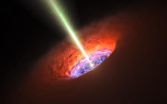Diversity is key to stability, grassland study finds
U of M research points to loss of species as common thread in reduced ecosystem stability following fire, fertilization and other human-induced changes
2015-04-16
(Press-News.org) Biological diversity brings beauty and variety to our lives and to the world around us. It also could be the key to keeping ecosystems strong, according to a new University of Minnesota study published April 17 in the journal Science.
The study, led by Yann Hautier a Marie Curie Fellow associated with the College of Biological Sciences at the University of Minnesota and with the University of Oxford, U.K., looked at 28 years' worth of data on plant growth, number of species, ecosystem stability and exposure to changes in nitrogen, carbon dioxide, fire, grazing and water collected from experimental grassland plots at Cedar Creek Ecosystem Science Reserve near East Bethel as part of other studies. It found that all of the human-induced changes affected the productivity of the grassland plots, but only those that reduced biodiversity reduced ecosystem stability.
"Basically, we found that any driver of environmental change that will cause a loss of plant diversity will in turn reduce the stable production of plant biomass through time," Hautier said. "Biodiversity is somehow a special case, because it's not only a cause of changes in ecosystems but also a response to other changes."
The study is unusual because it looks at several factors that affect ecosystem stability at the same time over a long period in a setting that kept other potential variables constant. It is important because understanding the cause-and-effect cascade of changes to ecosystems is key to anticipating impacts of human actions and minimizing damage to natural systems that undergird our planet's ability to support human life.
"The main message is that if we want to continue to benefit from the services that our ecosystems are providing, we should be very careful about preserving biodiversity," Hautier said.
Study co-author Forest Isbell, who was recently appointed associate director of Cedar Creek, underscored the importance of the research site in making the study possible. "Few, if any, natural ecosystems worldwide have been more thoroughly investigated than those at Cedar Creek Ecosystem Science Reserve," Isbell said. "Ecologists from around the world, such as Yann Hautier, are perpetually drawn to Cedar Creek and inspired to make new discoveries that transform our understanding of nature."
Based on the results, Hautier is now expanding his research to explore whether the decline in diversity affects natural grasslands' ability to provide multiple ecological benefits simultaneously. That work will take place through the Nutrient Network, an international collaboration coordinated by CBS faculty and study co-authors Eric Seabloom and Elizabeth Borer that makes it possible to conduct research on a variety of grassland ecosystems around the world at the same time.
"Because of Cedar Creek and the Nutrient Network, the University of Minnesota is uniquely positioned to contribute to understanding long-term, multi-continent problems," Borer said. "By providing new insights into the functioning and future of global environments, we hope such studies will help us keep ecosystems healthy in a fast-changing world."
INFORMATION:
Cedar Creek's director Regents Professor David Tilman and Regents Professor Peter Reich were also study co-authors.
ELSE PRESS RELEASES FROM THIS DATE:
2015-04-16
Through a combination of data analysis and numerical modeling work, researchers have found a record of the ancient Moon-forming giant impact observable in stony meteorites. Their work will appear in the April 2015 issue of the Journal Science. The work was done by NASA Solar System Exploration Research Virtual Institute (SSERVI) researchers led by Principal Investigator Bill Bottke of the Institute for the Science of Exploration Targets (ISET) team at the Southwest Research Institute and included Tim Swindle, director of the University of Arizona's Lunar and Planetary Laboratory.
The ...
2015-04-16
A skin cell responsible for scarring, and a molecule that inhibits the cell's activity, have been identified by researchers at the Stanford University School of Medicine.
The molecule slowed wound healing in mice but alleviated scarring, the researchers said.
The researchers also found that the cell may play a role in the growth of melanoma and in skin damage caused by radiation. A drug that acts in the same way as the inhibitory molecule is already approved for use in humans as a treatment for type-2 diabetes, so it could potentially move quickly into clinical trials ...
2015-04-16
For more than 250 million years, four-limbed land animals known as tetrapods have repeatedly conquered the Earth's oceans. These creatures--such as plesiosaurs, penguins and sea turtles--descended from separate groups of terrestrial vertebrates that convergently evolved to thrive in aquatic environments.
In a new scientific review, a team of Smithsonian scientists synthesized decades of scientific discoveries to illuminate the common and unique patterns driving the extraordinary transitions that whales, dolphins, seals and other species underwent as they moved from land ...
2015-04-16
Supermassive black holes, often with masses billions of times that of the Sun, are located at the heart of almost all galaxies in the Universe. These black holes can accrete huge amounts of matter in the form of a surrounding disc. While most of this matter is fed into the black hole, some can escape moments before capture and be flung out into space at close to the speed of light as part of a jet of plasma. How this happens is not well understood, although it is thought that strong magnetic fields, acting very close to the event horizon, play a crucial part in this process, ...
2015-04-16
A global study on canine rabies, published today (16 April 2015), has found that 160 people die every single day from the disease. The report is the first study to consider the impact in terms of deaths and the economic costs of rabies across all countries. Even though the disease is preventable, the study says that around 59,000 people die every year of rabies transmitted by dogs.
The multi-author study, by the Global Alliance for Rabies Control's Partners for Rabies Prevention Group, also shows that annual economic losses because of the disease are around 8.6 billion ...
2015-04-16
Scientists have discovered a protein that plays a central role in promoting immunity to viruses and cancer, opening the door to new therapies.
Experiments in mice and human cells have shown that the protein promotes the proliferation of cytotoxic T cells, which kill cancer cells and cells infected with viruses. The discovery was unexpected because the new protein had no known function and doesn't resemble any other protein.
Researchers from Imperial College London who led the study are now developing a gene therapy designed to boost the infection-fighting cells, and ...
2015-04-16
A major astrophysical mystery has centred on how massive, quiescent elliptical galaxies, common in the modern Universe, quenched their once furious rates of star formation. Such colossal galaxies, often also called spheroids because of their shape, typically pack in stars ten times as densely in the central regions as in our home galaxy, the Milky Way, and have about ten times its mass.
Astronomers refer to these big galaxies as red and dead as they exhibit an ample abundance of ancient red stars, but lack young blue stars and show no evidence of new star formation. The ...
2015-04-16
San Antonio -- April 16, 2015 -- A NASA-funded research team led by Dr. Bill Bottke of Southwest Research Institute (SwRI) independently estimated the Moon's age as slightly less than 4.5 billion years by analyzing impact-heated shock signatures found in stony meteorites originating from the Main Asteroid Belt. Their work will appear in the April 2015 issue of the journal Science.
"This research is helping to refine our time scales for 'what happened when' on other worlds in the solar system," said Bottke, of the Institute for the Science of Exploration Targets (ISET). ...
2015-04-16
April 16, 2015, NEW HAVEN, CT - With poor sanitation estimated to cause 280,000 deaths per year worldwide, improving sanitation is a key policy goal in many developing countries. Yet governments and major development institutions disagree over how to address the problem. A new study released in Science today found that in Bangladesh, a community-motivation model that has been used in over 60 countries to increase use of hygienic latrines had no effect, yet latrine coverage expands substantially when that model is combined with subsidies for hygienic latrines targeted to ...
2015-04-16
Astronomers from Chalmers University of Technology have used the giant telescope Alma to reveal an extremely powerful magnetic field very close to a supermassive black hole in a distant galaxy. The results appear in the 17 April 2015 issue of the journal Science.
A team of five astronomers from Chalmers University of Technology have revealed an extremely powerful magnetic field, beyond anything previously detected in the core of a galaxy, very close to the event horizon of a supermassive black hole. This new observation helps astronomers to understand the structure and ...
LAST 30 PRESS RELEASES:
[Press-News.org] Diversity is key to stability, grassland study finds
U of M research points to loss of species as common thread in reduced ecosystem stability following fire, fertilization and other human-induced changes





